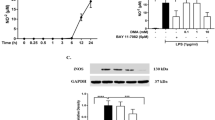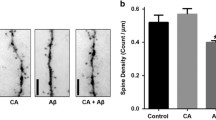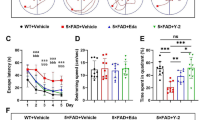Abstract
The importance of glial cell-driven neuroinflammation in the pathogenesis and progression of Alzheimer’s disease (AD) led us to initiate a drug discovery effort targeting the neuroinflammatory cycle that is characteristic of AD. We used our synthetic chemistry platform focused on bioavailable aminopyridazines as a new chemotype for AD drug discovery to develop novel, selective suppressors of key inflammatory and oxidative pathways in glia. We found that MW01-070C, an aminopyridazine that works via mechanisms distinct from NSAIDs and p38 MAPK inhibitors, attenuates β-amyloid (Aβ)-induced neuroinflammation and neuronal dysfunction in a dose-dependent manner, and prevents Aβ-induced behavioral impairment. In vivo data were obtained with a murine model that uses intraventricular infusion of human Aβ1–42 peptide and replicates many of the hallmarks of AD pathology, including neuroinflammation, neuronal and synaptic degeneration, and amyloid deposition. The quantifiable endpoint pathology is robust, reproducible, and rapid in onset. Our results provide a proof of concept that targeting neuroinflammation with aminopyridazines is a viable AD drug discovery approach that has the potential to modulate disease progression and document the utility of this mouse model for preclinical screening of compounds targeting AD-relevant neuroinflammation and neuronal death.
Similar content being viewed by others
References
Aisen P. S., Schafer K. A., Grundman M., Pfeiffer E., Sano M., Davis K. L., et al. (2003) Alzheimer’s Disease Cooperative Study. JAMA 289, 2819–2826.
Akiyama H., Barger S., Barnum S., Bradt B., Bauer J., Cole G. M., et al. (2000) Inflammation and Alzheimer’s disease. Neurobiol. Aging 21, 383–421.
Brookmeyer R., Gray S., and Kawas C. (1998) Projections on Alzheimer disease in the United States and the public health impact of delaying disease onset. Am. J. Public Health 88, 1337–1342.
Craft J. M., Watterson D. M., Frautschy S. A., and Van Eldik L. J. (2004) Aminopyridazines inhibit β-amyloid-induced glial activation and neuronal damage in vivo. Neurobiol Aging online March 2004.
Dahlgren K. N., Manelli A. M., Stine B., Baker L. K., Krafft G. A. and LaDu M. J. (2002) Oligomeric and fibrillar species of amyloid-β peptides differentially affect neuronal viability. J. Biol. Chem. 277, 32046–32053.
Dooley M. and Lamb H. M. (2000) Donepezil: a review of its use in Alzheimer’s disease. Drugs Aging 16, 199–226.
Edwards J. G., Dinan T. G., Waller D. G., and Greentree S. G. (1996) Double-blind comparative study of the anti-depressant, unwanted and cardiac effects of minaprine and amitriptyline. Br. J. Clin. Pharmacol. 42, 491–498.
Frautschy S. A., Hu W., Kim P., Miller S. A., Chu T., Harris-White M. E., and Cole G. M. (2001) Phenolic anti-inflammatory antioxidant reversal of Aβ-induced cognitive deficits and neuropathology. Neurobiol. Aging 22, 993–1005.
Frautschy S. A., Yang F., Calderon L. and Cole G. M. (1996) Rodent models of Alzheimer’s disease: rat Aβ infusion approaches to amyloid deposits. Neurobiol. Aging 17, 311–321.
Griffin W. S. T., Sheng J. G., Royston M. C., Gentleman S. M., McKenzie J. E., Graham D. I., et al. (1998) Glial-neuronal interactions in Alzheimer’s disease: the potential role of a “cytokine cycle” in disease progression. Brain Pathol. 8, 65–72.
Isley W. L. and Oki J. C. (2001) Hepatotoxicity of thiazolidinediones. Diabetes Obes. Metab. 3, 389–392.
Knopman D. S. (2000) Management of cognition and function: new results from the clinical trials programme of Aricept. Int. J. Neuropsychopharmacol. 3, 13–20.
Lipinski C. A. (2000) Drug-like properties and the causes of poor solubility and poor permeability. J. Pharmacol. Toxicol. Methods 44, 235–249.
Manley P. W., Martiny-Baron G., Schlaeppi J.- M., and Wood J. (2002) Therapies directed at vascular endothelial growth factor. Expert Opin. Invest. Drugs 11, 1715–1736.
McGeer E. G. and McGeer P. L. (2003) Clinically tested drugs for Alzheimer’s disease. Expert Opin. Invest. Drugs 12, 1143–1151.
Mirzoeva S., Sawker A., Zasadzki M., Guo L., Velentza A. V., Dunlap V., et al. (2002) Discovery of a 3-amino-6-phenyl-pyridazine derivative as a new synthetic antineuroinflammatory compound. J. Med. Chem. 45, 563–566.
Salzmann E. and Robin J.L. (1995) Multicentric double-blind study comparing efficacy and safety of minaprine and imipramine in dysthymic disorders. Neuropsychobiology 31, 68–75.
Stone W. S., Rudd R. J., and Gold P. E. (1992) Glucose attenuation of scopolamine-induced and age-induced deficits in spontaneous-alternation behavior and regional brain [H-3] 2-deoxyglucose uptake in mice. Psychobiology 20, 270–279.
Van Eldik L. J. and Griffin W. S. T. (1994) S100β expression in Alzheimer’s disease: relation to neuropathology in brain regions. Biochim. Biophys. Acta 1223, 398–403.
Vassar R., Bennett B. D., Babu-Khan S., Kahn S., Mendiaz E. A., Deni P., et al. (1999) Beta secretase cleavage of Alzheimer’s amyloid precursor protein by the transmembrane aspartic protease BACE. Science 286, 735–741.
Velentza A. V., Wainwright M. S., Zasadski M., Mirzoeva S., Schumacher A. M., Haiech J., et al. (2003) An aminopyridazine-based inhibitor of a pro-apoptotic protein kinase attenuates hypoxia-ischemia induced acute brain injury. Bioorg. Med. Chem. Lett. 13, 3465–3470.
Wainwright M. S., Rossi J., Schavocky J., Crawford S., Steinhorn D., Velentza A. V., et al. (2003) Protein kinase involved in lung injury susceptibility: evidence from enzyme isoform genetic knockout and in vivo inhibitor treatment. Proc. Natl. Acad. Sci. U. S. A. 100, 6233–6238.
Watterson D. M., Velentza A. V., Zasadzki M., Craft J. M., Haiech J., and Van Eldik L. J. (2002) Discovery of a new class of synthetic protein kinase inhibitors that suppress selective aspects of glial activation and protect against β-amyloid induced injury. J. Mol. Neurosci. 20, 411–423.
Weiss C., Shroff A., and Disterhoft J. F. (1998) Spatial learning and memory in aging C57BL/6 mice. Neurosci. Res. Comm. 23, 77–92.
Wermuth C. G. (1993) Aminopyridazines—an alternative route to potent muscarinic agonists with no cholinergic syndrome. Farmaco 48, 253–274.
Wermuth C. G. (1998) Search for new lead compounds: The example of the chemical and pharmacological dissection of aminopyridazines. J. Heterocyclic Chem. 35, 1091–1100.
Xia W. (2000) Role of presenilin in gamma-secretase cleavage of amyloid precursor protein. Exp. Gerontol. 35, 453–460.
Author information
Authors and Affiliations
Corresponding author
Rights and permissions
About this article
Cite this article
Craft, J.M., Van Eldik, L.J., Zasadzki, M. et al. Aminopyridazines attenuate hippocampus-dependent behavioral deficits induced by human β-amyloid in a murine model of neuroinflammation. J Mol Neurosci 24, 115–122 (2004). https://doi.org/10.1385/JMN:24:1:115
Issue Date:
DOI: https://doi.org/10.1385/JMN:24:1:115




